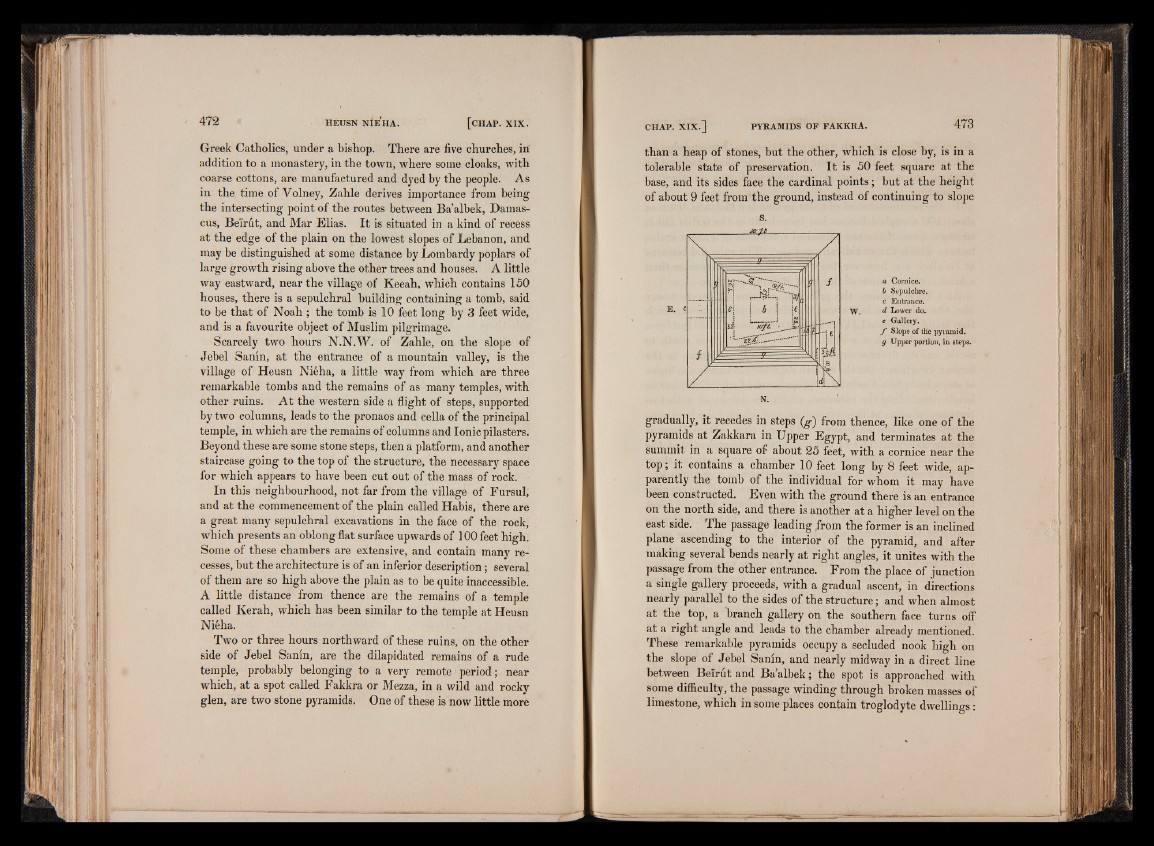
Greek Catholics, under a bishop. There are five churches, iii
addition to a monastery, in the town, where some cloaks, with
coarse cottons, are manufactured and dyed by the people. As
in the time of Volney, Zahle derives importance from being
the intersecting point of the routes between Baalbek, Damascus,
Beirut, and Mar Elias. It is situated in a kind of recess
at the edge of the plain on the lowest slopes of Lebanon, and
may be distinguished at some distance by Lombardy poplars of
large growth rising above the other trees and houses. A little
way eastward, near the village of Keeah, which contains 150
houses, there is a sepulchral building containing a tomb, said
to be that of Noah ; the tomb is 10 feet long by 3 feet wide,
and is a favourite object of Muslim pilgrimage.
Scarcely two hours N.N.W. of Zahle, on the slope of
Jebel Sanin, at the entrance of a mountain valley, is the
village of Heusn Nieha, a little way from which are three
remarkable tombs and the remains of as many temples, with
other ruins. At the western side a flight of steps, supported
by two columns, leads to the pronaos and cella of the principal
temple, in which are the remains of columns and Ionic pilasters.
Beyond these are some stone steps, then a platform, and another
staircase going to the top of the structure, the necessary space
for which appears to have been cut out of the mass of rock.
In this neighbourhood, not far from the village of Fursul,
and at the commencement of the plain called Habis, there are
a great many sepulchral excavations in the face of the rock,
which presents an oblong flat surface upwards of 100 feet high.
Some of these chambers are extensive, and contain many recesses,
but the architecture is of an inferior description; several
of them are so high above the plain as to be quite inaccessible.
A little distance from thence are the remains of a temple
called Kerah, which has been similar to the temple at Heusn
Nieha.
Two or three hours northward of these ruins, on the other
side of Jebel Sanin, are the dilapidated remains of a rude
temple, probably belonging to a very remote period; near
which, at a spot called Fakkra or Mezza, in a wild and rocky
glen, are two stone pyramids. One of these is now little more
than a heap of stones, but the other, which is close by, is in a
tolerable state of preservation. It is 50 feet square at the
base, and its sides face the cardinal points; but at the height
of about 9 feet from the ground, instead of continuing to slope
a Cornice.
b Sepulchre.
c Entrance.
d Lower do.
e Gallery.
f Slope of the pyramid.
g Upper portion, in steps.
N.
gradually, it recedes in steps (g) from thence, like one of the
pyramids at Zakkara in Upper Egypt, and terminates at the
summit in a square of about 25 feet, with a cornice near the
top; it contains a chamber 10 feet long by 8 feet wide, apparently
the tomb of the individual for whom it may have
been constructed. Even with the ground there is an entrance
on the north side, and there is another at a higher level on the
east side. The passage leading jrom the former is an inclined
plane ascending to the interior of the pyramid, and after
making several bends nearly at right angles, it unites with the
passage from the other entrance. From the place of junction
a single gallery proceeds, with a gradual ascent, in directions
nearly parallel to the sides of the structure; and when almost
at the top, a branch gallery on the southern face turns off
at a right angle and leads to the chamber already mentioned.
These remarkable pyramids occupy a secluded nook high on
the slope of Jebel Sanin, and nearly midway in a direct line
between Beirut and Ba’albek; the spot is approached with
some difficulty, the passage winding through broken masses of
limestone, which in some places contain troglodyte dwellings: